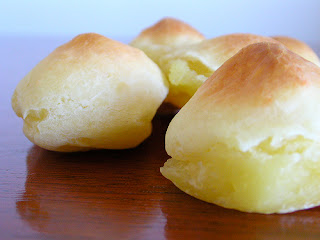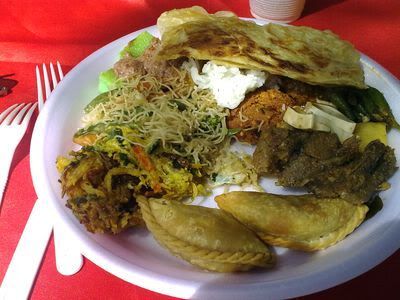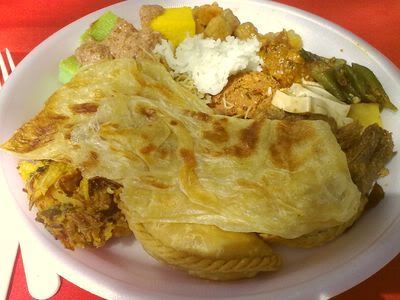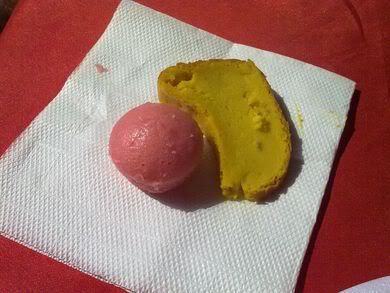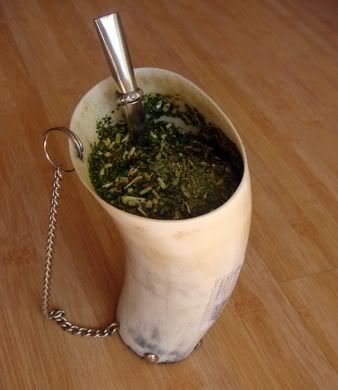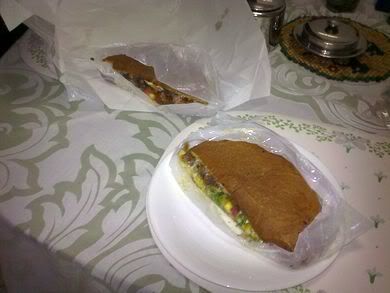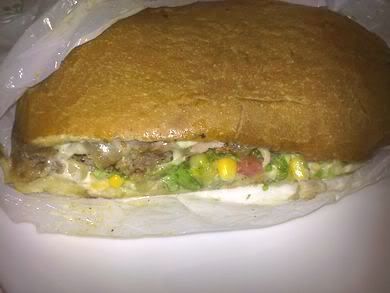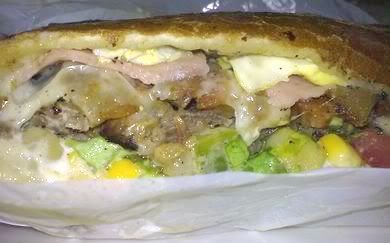I have just mentioned the so called "cheese bread", wich happens to be a very popular component of the Brazilian breakfast. It can be compared, to some degree, to the pancakes or waffles in the America and European versions.
Brazil is a pretty big country, so the breakfast table varies quite a lot, depending on where you are. The one described here is valid for Brasilia, Rio and probably São Paulo as well (Central Region). Besides the "cheese bread", the favourite things to have is the classic combination coffe and milk with toast. Not the toast most people know. It is a little different. In Brazil, we have something called "French Bread". Don't ask me why, for I have never seen a French Bread outside Brazil-not even in France. It can be described as a mini-baguette, about the size of a croissant. I believe all Brazilians eat that. Honestly... When the "French Bread" price rises, the population gets pretty angry! The toast is made with this bread; cut in half. Butter is spread all over its inner side and it is put on a very hot metal plate to grill - "Chapa", we call it.
It comes together with the coffee, usually mixed with milk, and served on a glass, rather than a cup. Since it is often served half coffee/half milk, it is known here as "Média", which can be translated as "Mean". This breakfast is often served in most bakeries around the country. Rio de Janeiro is notorious for the routine of workers that take a little time in some bakery before going to work, in order to have some of these.
As far as I can tell, this "Brazilian breakfast" (I just invented this expression) is for some unexplainable reason much better in Rio than here in Brasilia... And strange as it may seem, the less inviting the bakery will look, the best the breakfas will be. I had unforgettable breakfasts in some very dirty-looking places. They are the best!
I don't believe this will ever figure in a traveller's guide, but stopping at one of those bakeries for a coffee and a grilled bread is really worth the time!
TooYummyForYourTummy
food, food, food everywhere!
Friday, August 19
Friday, April 8
"Pão de Queijo"
Literally, it means "Cheese Bread". Tough it was consumed very often in the Brazilian countryside, it was only in the late 40's/ early 50's that it became popular in the big cities. It is made of cassava powder - usually fermented, eggs, butter (sometimes vegetable oil or pork fat are used as to replace the butter), salt and obviously CHEESE! The most common choices are parmesan, mozzarella, and two chesses made in the province of Minas Gerais in Brazil; called "Minas Cheese" (white and soft) and "Regular Minas Cheese" (yellow and hard) the latter being a stronger tasting version of the former.
The "pão de queijo" is usually baked in the oven and, when properly made, it has a very crunchy crust and a soft and gummy core. Many people cut them in half and add some kind of jam (strawberry being my favourite - it tastes really great!!) or some creamy cheese. There is a fried version as well, known as "cheese biscuit". Tough it tastes pretty good, you can hardly eat lots of them: you will quiqly feel stuffed with them.
Monday, January 10
The Anta Sausage
It was new year's eve and my friends came over my place to celebrate. Every year we get together and each one of us brings something to drink or eat. This year, I decided to make two sausages (one made out of pork and the other one of chicken) according to my father's recipe. It's extremely easy to do, even though it's quite time consuming - took me almost 2h to fix everything!
This is not even a typical brazilian dish, as far as I know... It consists of placing a sausage of your choice inside a pan with water, salt and minced onions. Boil it as if there was no tomorrow... The sausage will grill in its own fat once the water is gone. The result has a pretty strong taste, specially because of the onion. Once it is ready, you just have to cut in pieces and eat with a toothpick.
The name "Anta" is an invention of mine, because of my grandfather's hometown.
Almost ready to serve!!
Friday, October 8
Brunch at VAGAFOGO
So... This weekend I travelled with my girlfriend to a small village in the Brazilian countryside named Pirenopolis. It is located in the State of Goias, which is well known for its unique cuisine, that includes local ingredients (such as the baru nut or the pequi fruit) and traditional dishes (Galinhada - chicken with corn, pequi and rice).
Around Pirenopolis, there is a well-known farm named Vagafogo. From 9h to 16h30, a generous brunch is served to the visitors. It was highly spoken of to me, so it was an obvious destination. It is really worth the visit if you are in the region, because everything there is locally made and tastes very fresh. Many recipies are exclusive from the farm owners and cannot be found anywhere else in town.
My table in the beggining of the brunch: diversity and quantity teaming up...
Three kinds of bread were offered: whole grain, honey bread and milk and butter bread. The bread was served with a wide variety of jams, marmelades and chutneys, some of wich were made out of typical fruits from the region, such as cagaita, pitanga, pequi, starfruit, jabuticaba among others; some of them mixed with pepper for a sweet-spicy taste. There was also three different kinds of creamy cheese, "Minas" type cheese and home-made chanclich. Scrambled eggs were served as well. There was also some meat, preserved in olive oil with spices.
However, my favourite toppings were the dry ambrosia, made out of caramel milk and the "farofa cearense", made with cassava flour and old butter. The visit was really worth it!
Meat and chutneys
Wednesday, August 11
Malaysian Food Festival
As far as I know, there is no Malaysian Restaurant in Brazil (maybe in São Paulo or Rio de Janeiro; the largest cities). Thus, I was really looking forward to try this country's cuisine when I learned about a gastronomic festival held by the Malaysian Embassy.
So, there I was in a hot saturday afternoon ready to try anything that would come my way. And so I did. The menu was extremely diverse, with a wide variety of dishes. Many vegetables, meat, chicken and fish were available with exotic sauces.
The peanut and coconut sauce was particularly savoury. It made a perfect combination with the curry puffs filled with potatoes and vegetables, very similar to Indian samoosa. The prawn fritter was very good as well. There was also a sauteed beef with spices (lemongrass and star anis, I think), a sweet and sour fish and a shrimp salad named "Ulam with Sambal Belacan". All of thoise had me coming back for more... I tried the traditional "Roti Canai"-malaysian pancakes, very similar to a pancake my grandmother used to make when I was a child. It was really delicious.
Roti Canai
The pink cake is made out of rice flour. As for the yellow one, I have no idea what it was.
For the dessert, there was a wide variety of cakes, including the "ant-hill cake" (kek serang semut), which has drawn my attention for being a very common cake in Brazil as well. This is probably a common portuguese heritage?
Finally, they served their traditional tea, the "teh tarik", wich means litteraly "pulled tea". It is a mixture of black tea with milk, with a smooth and foamy texture because of how it is made: the person quickly pours the tea from one jar to another repeatedly, untill it gets the desired constitution. Hence the name "pulled tea".
Friday, August 6
Ilex Paraguariensis
...is the scientific name of the plant known as "Erva Mate" (Mate tea). It is a shrub that grows in southern and central area of Brazil, being found in Paraguay, Uruguay and Argentina as well. The Guarani indians used to mix leaves and other parts of this plant with water to make a bitter-tasting tea out of it.
Legend states that the plant was offered to an old indian hermit by a stray emissary of God, in exchange for generous shelter and food offered by his host. The plant, named "Cáa Yaráa" would be a past time for moments of solitude, as a healthy and tasty beverage could be made from it.
According to the tradition (drinking mate is a true ritual), tea can be consumed hot, inside a recipient named cuia. In this case, it is known as chimarrão (from the spanish word cimarrón-wild cattle) and the herb used is very powdery and lush-green. When consumed cold, it is better known as tererê. It is served inside a guampa-a slice of a bull's horn with a wooden bottom. The horn has 3/4 of it filled with a roughly cut herb (slices of leaves and wooden sticks). After filling it, one has to lay it horizontally, covering the open part with his hand. Thus, the herb will be disposed in a way that water can be poured in. Finally, one has to place the "pump" (bomba), a metalic straw-like tool used to filter and drink the water.
Cold tererê inside the guampa. Ready to drink!
You cannot move the pump once it is placed or the herb may block the passage of water, making it difficult to drink. The one who prepares the tererê drinks the water until a loud noise can be heard, meaning it is empty. This act is called "making the guampa snore". Then it is filled again and shared between friends. This usually happens in the countryside, where cattle herders get together around the fire at night to tell stories, sing, eat and drink.
A drop of tea.
In Brazil, tererê is very common in the Central Region, specially in Pantanal. It is also widely consummed in Paraguay. As for the hot variety, chimarrão, it is more common in Uruguay, Argentina and the Southern part of Brazil. I am more of a tererê drinker myself, though I appreciate a hot chimarrão from time to time...
That's how the erva mate for tererê looks like.
Monday, July 26
The Great Clogger
Brazilian food is not exactly healthy. If you take for example some of the most popular dishes in the country - feijoada, acarajé, churrasco - they'll all present highly above-average levels of cholesterol/fat. Also, brazilian people tend to like extremely salty or sweet food (at least for international standards).
In the South, they have a typical hamburger wich they call "X-Gaúcho" or "Hamburguer Gaúcho". The "X" stands for "cheese", which is how this letter sounds like in portuguese. Thus, in Brazil, we have the "X-Salada", meaning a hamburguer with cheese and salad, and the "X-Tudo" (lit. X-Everything). The particularity of the Gaucho-burger is its size. The bread is almost as big as a regular dessert plate. It always comes split in halves, for it's almost impossible for one person to eat one of those alone. As for what comes inside, besides the hamburger meat you will find corn, green peas, cheese and mayonnaise, in its simpler version. There are lots of varieties. Near my house, they sell a really big one named "X-Campeiro" (Cheese Countryside). Curious about the stuffing?
- A Hamburguer
- 2 slices of cheese
- Some mayonnaise
- One fried egg
- A slice of ham
- Green peas
- Corn
- Minced bacon
- Minced Calabresa sausage
- Minced chicken hearts
- Tomatoes
- Chopped lettuce
I swear it is HUGE (and as delicious as it looks)! If you have heart problems, you'd better run away from it!
Subscribe to:
Posts (Atom)

